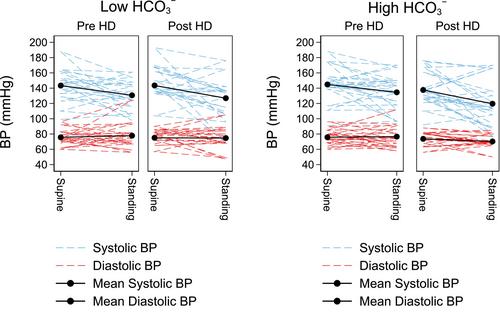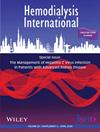Hemodynamic effects of low versus high dialysate bicarbonate concentration in hemodialysis patients
Abstract
Introduction
Hemodialysis treatment using standard dialysate bicarbonate concentrations cause transient metabolic alkalosis possibly associated with hemodynamic instability. The aim of this study was to perform a detailed comparison of high and low dialysate bicarbonate in terms of blood pressure, intradialytic hemodynamic parameters, orthostatic blood pressure, and electrolytes.
Methods
Fifteen hemodialysis patients were examined in a single-blind, randomized, controlled, crossover study. Participants underwent a 4-h hemodialysis session with dialysate bicarbonate concentration of 30 or 38 mmol/L with 1 week between interventions. Blood pressure was monitored throughout hemodialysis, while cardiac output, total peripheral resistance, stroke volume, and central blood volume were assessed with ultrasound dilution technique (Transonic). Orthostatic blood pressure was measured pre- and post-hemodialysis.
Findings
With similar ultrafiltration (UF) volume (2.6 L), systolic blood pressure (SBP) tended to decrease more during high dialysate bicarbonate compared to low dialysate bicarbonate; the mean (95% confidence interval) between treatment differences in SBP were: 8 (−4; 20) mmHg (end of hemodialysis) and 7 (0; 15) mmHg (post-hemodialysis). Stroke volume decreased whereas total peripheral resistance increased significantly more during high dialysate bicarbonate compared to low dialysate bicarbonate with mean between treatment differences: Stroke volume: 12 (1; 23) mL; Total peripheral resistance: −2.9 (−5.3; −0.5) mmHg/(L/min). Cardiac output tended to decrease more with high dialysate bicarbonate compared to low dialysate bicarbonate with mean between treatment difference 0.7 (0.0; 1.4) L/min. High dialysate bicarbonate caused alkalosis, hypocalcemia, and lower plasma potassium, whereas patients remained normocalcemic with normal pH during low dialysate bicarbonate. Orthostatic blood pressure response after dialysis did not differ significantly.
Discussion
The use of high dialysate bicarbonate compared to low dialysate bicarbonate was associated with hypocalcemia, alkalosis, and a more pronounced hypokalemia. During hemodialysis with UF, a better preservation of blood pressure, stroke volume, and cardiac output may be achieved with low dialysate bicarbonate compared to high dialysate bicarbonate.


 求助内容:
求助内容: 应助结果提醒方式:
应助结果提醒方式:


